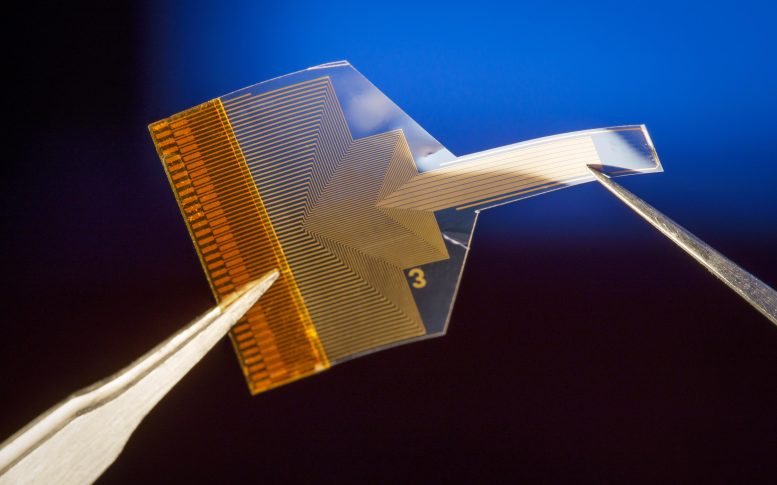
Researchers have developed a revolutionary neural implant, combining the advantages of surface and deep probing technologies. This transparent, flexible implant with high-density graphene electrodes offers high-resolution data on both surface and deep neural activities. Credit: SciTechDaily.com
A new neural implant revolutionizes brain activity monitoring, combining surface and deep brain data acquisition in a minimally invasive manner.
Scientists at the University of California San Diego have developed a neural implant that provides information about activity deep inside the brain while sitting on its surface. The implant is made up of a thin, transparent and flexible polymer strip that is packed with a dense array of
Overcoming Current Limitations in Neural Implants
“We are expanding the spatial reach of neural recordings with this technology,” said study senior author Duygu Kuzum, a professor in the Department of Electrical and Computer Engineering at the UC San Diego Jacobs School of Engineering. “Even though our implant resides on the brain’s surface, its design goes beyond the limits of physical sensing in that it can infer neural activity from deeper layers.”

When placed on the surface of the brain, this thin, flexible implant enables researchers to capture high-resolution information about neural activity deep inside the brain without damaging its delicate tissue. Credit: David Baillot/UC San Diego Jacobs School of Engineering
This work overcomes the limitations of current neural implant technologies. Existing surface arrays, for example, are minimally invasive, but they lack the ability to capture information beyond the brain’s outer layers. In contrast, electrode arrays with thin needles that penetrate the brain are capable of probing deeper layers, but they often lead to inflammation and scarring, compromising signal quality over time.
The new neural implant developed at UC San Diego offers the best of both worlds.
Implant Details
The implant is a thin, transparent, and flexible polymer strip that conforms to the brain’s surface. The strip is embedded with a high-density array of tiny, circular graphene electrodes, each measuring 20 micrometers in diameter. Each electrode is connected by a micrometers-thin graphene wire to a circuit board.
In tests on transgenic mice, the implant enabled the researchers to capture high-resolution information about two types of neural activity–electrical activity and calcium activity–at the same time. When placed on the surface of the brain, the implant recorded electrical signals from neurons in the outer layers. At the same time, the researchers used a two-
Closeup of the graphene electrode array. Credit: David Baillot/UC San Diego Jacobs School of Engineering